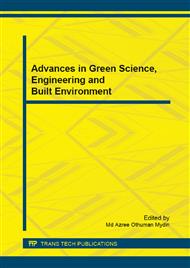p.16
p.20
p.24
p.28
p.32
p.36
p.40
p.44
p.48
Green Agenda: A Socio-Cultural Response to Sick Building Syndrom (SBS) and Building Related Illness (BRI) in African Domestic Architecture
Abstract:
Green agenda is a participatory method for developing and implementing local sustainable development strategies and plans with active involvement of different sectors in the local community where the process is conducted. But Sick Building Syndrome (SBS) and Building Related Illness (BRI) are building concerns in African cities, because building designs, materials and styles are alien the culture and climate. The focus of the paper therefore was to deploy sustainability parameters (Green Agenda) to address SBS and BRI in African Domestic Architecture. Taking into consideration the three main aspects of green agenda which includes; identifying local values, process participation and genuinely owned result. The methodology employed was quantitative and qualitative. The findings revealed that the research had addressed the issues of imported design, sick building syndrome and building related illness using sustainability considerations. The study result has shown that the three aspects of local green agenda has socio-cultural nuance in Domestic Architecture that includes the values, beliefs, available materials in the studied community. This pre-supposes that building design necessarily need to have organic content (i.e. it has to be culture specific, socially responsive and environmentally friendly). Organic designs however have proved to be sustainable and also one of the way out of SBS and BRI. Keywords: Green Agenda, Agenda 21, Habitat Agenda, Socio-Cultural, Domestic Architecture, SBS and BRI
Info:
Periodical:
Pages:
32-35
Citation:
Online since:
March 2015
Authors:
Keywords:
Price:
Сopyright:
© 2015 Trans Tech Publications Ltd. All Rights Reserved
Share:
Citation:


